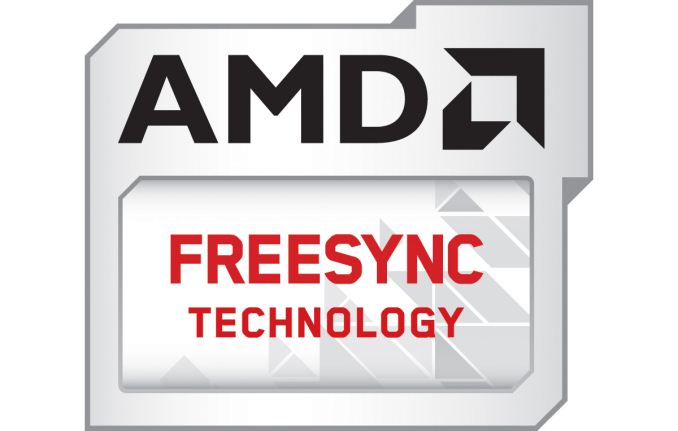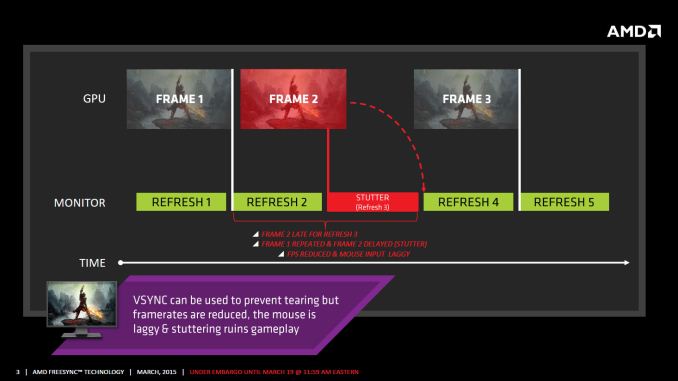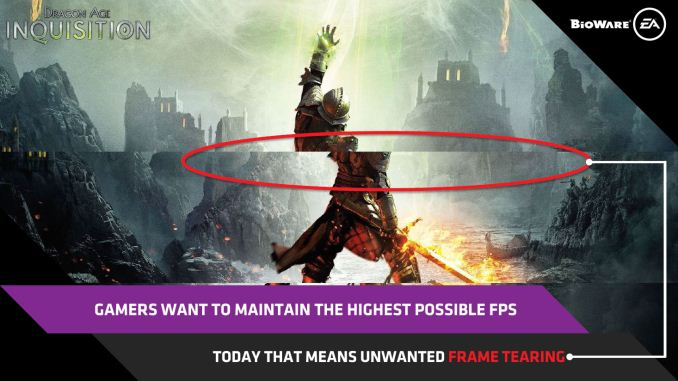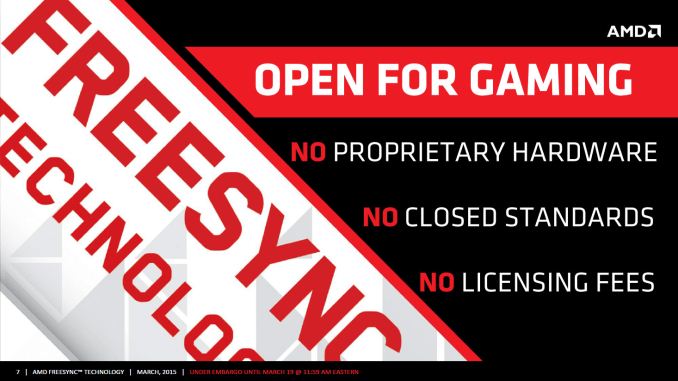The AMD FreeSync Review
by Jarred Walton on March 19, 2015 12:00 PM EST
Introduction to FreeSync and Adaptive Sync
The first time anyone talked about adaptive refresh rates for monitors – specifically applying the technique to gaming – was when NVIDIA demoed G-SYNC back in October 2013. The idea seemed so logical that I had to wonder why no one had tried to do it before. Certainly there are hurdles to overcome, e.g. what to do when the frame rate is too low, or too high; getting a panel that can handle adaptive refresh rates; supporting the feature in the graphics drivers. Still, it was an idea that made a lot of sense.
The impetus behind adaptive refresh is to overcome visual artifacts and stutter cause by the normal way of updating the screen. Briefly, the display is updated with new content from the graphics card at set intervals, typically 60 times per second. While that’s fine for normal applications, when it comes to games there are often cases where a new frame isn’t ready in time, causing a stall or stutter in rendering. Alternatively, the screen can be updated as soon as a new frame is ready, but that often results in tearing – where one part of the screen has the previous frame on top and the bottom part has the next frame (or frames in some cases).
Neither input lag/stutter nor image tearing are desirable, so NVIDIA set about creating a solution: G-SYNC. Perhaps the most difficult aspect for NVIDIA wasn’t creating the core technology but rather getting display partners to create and sell what would ultimately be a niche product – G-SYNC requires an NVIDIA GPU, so that rules out a large chunk of the market. Not surprisingly, the result was that G-SYNC took a bit of time to reach the market as a mature solution, with the first displays that supported the feature requiring modification by the end user.
Over the past year we’ve seen more G-SYNC displays ship that no longer require user modification, which is great, but pricing of the displays so far has been quite high. At present the least expensive G-SYNC displays are 1080p144 models that start at $450; similar displays without G-SYNC cost about $200 less. Higher spec displays like the 1440p144 ASUS ROG Swift cost $759 compared to other WQHD displays (albeit not 120/144Hz capable) that start at less than $400. And finally, 4Kp60 displays without G-SYNC cost $400-$500 whereas the 4Kp60 Acer XB280HK will set you back $750.
When AMD demonstrated their alternative adaptive refresh rate technology and cleverly called it FreeSync, it was a clear jab at the added cost of G-SYNC displays. As with G-SYNC, it has taken some time from the initial announcement to actual shipping hardware, but AMD has worked with the VESA group to implement FreeSync as an open standard that’s now part of DisplayPort 1.2a, and they aren’t getting any royalties from the technology. That’s the “Free” part of FreeSync, and while it doesn’t necessarily guarantee that FreeSync enabled displays will cost the same as non-FreeSync displays, the initial pricing looks quite promising.
There may be some additional costs associated with making a FreeSync display, though mostly these costs come in the way of using higher quality components. The major scaler companies – Realtek, Novatek, and MStar – have all built FreeSync (DisplayPort Adaptive Sync) into their latest products, and since most displays require a scaler anyway there’s no significant price increase. But if you compare a FreeSync 1440p144 display to a “normal” 1440p60 display of similar quality, the support for higher refresh rates inherently increases the price. So let’s look at what’s officially announced right now before we continue.













350 Comments
View All Comments
steve4king - Tuesday, March 24, 2015 - link
Seiki will be releasing DP1.3 on a 4k monitor Q3 2015, however, for whatever reason, it's still going to be 60hz. Now if other monitors follow suit and R300 also includes displayPort 1.3 we can get out of this bottleneck!wyewye - Friday, March 20, 2015 - link
This is not a review, its a blatant brown-nosing to Amd fest.Nvidia can at any time add support for Adaptive sync in their drivers, thus supporting both Gsync and Adaptive sync.
Amd will never be able to suppory both.
Looks like Nvidia has all the options.
silverblue - Friday, March 20, 2015 - link
They can, but why would they? As for AMD using NVIDIA tech, well... that's a well-trodden path and we all know what's at the end.ijozic - Friday, March 20, 2015 - link
Hmm.. All the listed screens are budget ones.. There are all either TN film or low res IPS screens. I hope it's just time needed for manufacturers to churn out their top models (e.g. 1440p 34" IPS or 27" 1440p 144Hz AHVA) and not some trend.JarredWalton - Friday, March 20, 2015 - link
By your logic all the G-SYNC displays are equally lousy (TN), with the exception of the upcoming Acer XB270HU. It's one of the primary complaints I have with G-SYNC to date: TN is usable, but IPS/AHVA/MVA are all better IMO.Side note: anyone else notice that IPS panels (esp. on laptops) seem to have issues with image persistence? I swear, I've played with laptops that are only a few months old and if you have a static window like Word open and then switch to a solid blue background or similar you'll see the Word outline remain for several minutes. Maybe it's just less expensive panels, but I don't know....
Strunf - Friday, March 20, 2015 - link
I have an Intel CPU and a nVIDIA GC but bravo AMD that despite being some kind of underdog does revolutionize the market on the right way, Mantle, Freesync, what's next?I'm convinced Intel will support Freesync in the near future, I don't see why not, it's free and easy to implement on the graphics circuit and the monitors can benefit from it at almost no cost (proved by the firmware upgrades)...
ComputerGuy2006 - Friday, March 20, 2015 - link
No talk at all about ULMB (Ultra Low Motion Blur)? I am guessing its just not supported?JarredWalton - Friday, March 20, 2015 - link
It's a display feature, not a FreeSync feature.zodiacfml - Friday, March 20, 2015 - link
Just get 120hz displays and be done with it.knightspawn1138 - Friday, March 20, 2015 - link
I think that since AMD has gotten the FreeSync details built into DisplayPort specifications, then all NVidia would have to do to be compatible with a FreeSync monitor is update their DisplayPort to the same revision. G-Sync will have to come down in price, or offer a significant benefit that isn't matched by FreeSync in order to stay viable.